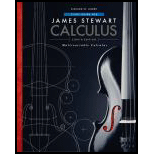
Study Guide for Stewart's Multivariable Calculus, 8th
8th Edition
ISBN: 9781305271845
Author: Stewart, James
Publisher: Brooks Cole
expand_more
expand_more
format_list_bulleted
Concept explainers
Question
Chapter 11.2, Problem 3PT
To determine
Whether the statement, “
Expert Solution & Answer
Trending nowThis is a popular solution!

Students have asked these similar questions
Determine whether the lines
L₁ (t) = (-2,3, −1)t + (0,2,-3) and
L2 p(s) = (2, −3, 1)s + (-10, 17, -8)
intersect. If they do, find the point of intersection.
Convert the line given by the parametric equations y(t)
Enter the symmetric equations in alphabetic order.
(x(t)
= -4+6t
= 3-t
(z(t)
=
5-7t
to symmetric equations.
Find the point at which the line (t) = (4, -5,-4)+t(-2, -1,5) intersects the xy plane.
Chapter 11 Solutions
Study Guide for Stewart's Multivariable Calculus, 8th
Ch. 11.1 - limnn2+3n2n2+n+1= a) 0 b) 12 c) 1 d)Ch. 11.1 - Prob. 2PTCh. 11.1 - Prob. 3PTCh. 11.1 - Sometimes, Always, or Never: If {an} is increasing...Ch. 11.1 - Prob. 5PTCh. 11.1 - Prob. 6PTCh. 11.1 - Prob. 7PTCh. 11.1 - Prob. 8PTCh. 11.2 - Prob. 1PTCh. 11.2 - Prob. 2PT
Ch. 11.2 - Prob. 3PTCh. 11.2 - Prob. 4PTCh. 11.2 - Prob. 5PTCh. 11.2 - Prob. 6PTCh. 11.2 - Prob. 7PTCh. 11.2 - Prob. 8PTCh. 11.3 - For what values of p does the series n=11(n2)p...Ch. 11.3 - True or False: If f(x) is continuous and...Ch. 11.3 - Prob. 3PTCh. 11.3 - Prob. 4PTCh. 11.3 - Prob. 5PTCh. 11.3 - Prob. 6PTCh. 11.4 - Prob. 1PTCh. 11.4 - Prob. 2PTCh. 11.4 - True or False: n=1n+n3n2/3+n3/2+1 is a convergent...Ch. 11.4 - Prob. 4PTCh. 11.4 - Prob. 5PTCh. 11.5 - Prob. 1PTCh. 11.5 - Prob. 2PTCh. 11.5 - Prob. 3PTCh. 11.5 - Prob. 4PTCh. 11.6 - Prob. 1PTCh. 11.6 - Prob. 2PTCh. 11.6 - Prob. 3PTCh. 11.6 - Prob. 4PTCh. 11.6 - Prob. 5PTCh. 11.6 - Prob. 6PTCh. 11.7 - Prob. 1PTCh. 11.7 - Prob. 2PTCh. 11.7 - Prob. 3PTCh. 11.7 - Prob. 4PTCh. 11.7 - Prob. 5PTCh. 11.7 - Prob. 6PTCh. 11.8 - Sometimes, Always, or Never: The interval of...Ch. 11.8 - Prob. 2PTCh. 11.8 - Prob. 3PTCh. 11.8 - Prob. 4PTCh. 11.8 - Prob. 5PTCh. 11.9 - Prob. 1PTCh. 11.9 - For f(x)=n=0x2nn!, f(x) = a) n=1x2n1n! b)...Ch. 11.9 - Using 11x=n=0xn for |x| 1, x1x2dx= a) n=0x2n2n b)...Ch. 11.9 - Using 11x=n=0xn for |x| 1 and differentiation,...Ch. 11.9 - From 11x=n=0xn for |x| 1 and substituting 4x2 for...Ch. 11.10 - Given the Taylor Series ex=n=0xnn!, a Taylor...Ch. 11.10 - Prob. 2PTCh. 11.10 - Prob. 3PTCh. 11.10 - Prob. 4PTCh. 11.10 - Prob. 5PTCh. 11.10 - Prob. 6PTCh. 11.10 - Prob. 7PTCh. 11.10 - Prob. 8PTCh. 11.10 - Prob. 9PTCh. 11.10 - Prob. 10PTCh. 11.10 - Using a binomial series, the Maclaurin series for...Ch. 11.10 - Prob. 12PTCh. 11.11 - Prob. 1PTCh. 11.11 - Prob. 2PTCh. 11.11 - Prob. 3PT
Knowledge Booster
Learn more about
Need a deep-dive on the concept behind this application? Look no further. Learn more about this topic, calculus and related others by exploring similar questions and additional content below.Similar questions
- Find the distance from the point (-9, -3, 0) to the line ä(t) = (−4, 1, −1)t + (0, 1, −3) .arrow_forward1 Find a vector parallel to the line defined by the parametric equations (x(t) = -2t y(t) == 1- 9t z(t) = -1-t Additionally, find a point on the line.arrow_forwardFind the (perpendicular) distance from the line given by the parametric equations (x(t) = 5+9t y(t) = 7t = 2-9t z(t) to the point (-1, 1, −3).arrow_forward
- Let ä(t) = (3,-2,-5)t + (7,−1, 2) and (u) = (5,0, 3)u + (−3,−9,3). Find the acute angle (in degrees) between the lines:arrow_forwardA tank initially contains 50 gal of pure water. Brine containing 3 lb of salt per gallon enters the tank at 2 gal/min, and the (perfectly mixed) solution leaves the tank at 3 gal/min. Thus, the tank is empty after exactly 50 min. (a) Find the amount of salt in the tank after t minutes. (b) What is the maximum amount of salt ever in the tank?arrow_forwardpleasd dont use chat gptarrow_forward
- Draw the vertical and horizontal asymptotes. Then plot the intercepts (if any), and plot at least one point on each side of each vertical asymptote.arrow_forwardDraw the asymptotes (if there are any). Then plot two points on each piece of the graph.arrow_forwardCancel Done RESET Suppose that R(x) is a polynomial of degree 7 whose coefficients are real numbers. Also, suppose that R(x) has the following zeros. -1-4i, -3i, 5+i Answer the following. (a) Find another zero of R(x). ☐ | | | | |│ | | | -1 བ ¢ Live Adjust Filters Croparrow_forward
arrow_back_ios
SEE MORE QUESTIONS
arrow_forward_ios
Recommended textbooks for you
 Calculus: Early TranscendentalsCalculusISBN:9781285741550Author:James StewartPublisher:Cengage Learning
Calculus: Early TranscendentalsCalculusISBN:9781285741550Author:James StewartPublisher:Cengage Learning Thomas' Calculus (14th Edition)CalculusISBN:9780134438986Author:Joel R. Hass, Christopher E. Heil, Maurice D. WeirPublisher:PEARSON
Thomas' Calculus (14th Edition)CalculusISBN:9780134438986Author:Joel R. Hass, Christopher E. Heil, Maurice D. WeirPublisher:PEARSON Calculus: Early Transcendentals (3rd Edition)CalculusISBN:9780134763644Author:William L. Briggs, Lyle Cochran, Bernard Gillett, Eric SchulzPublisher:PEARSON
Calculus: Early Transcendentals (3rd Edition)CalculusISBN:9780134763644Author:William L. Briggs, Lyle Cochran, Bernard Gillett, Eric SchulzPublisher:PEARSON Calculus: Early TranscendentalsCalculusISBN:9781319050740Author:Jon Rogawski, Colin Adams, Robert FranzosaPublisher:W. H. Freeman
Calculus: Early TranscendentalsCalculusISBN:9781319050740Author:Jon Rogawski, Colin Adams, Robert FranzosaPublisher:W. H. Freeman
 Calculus: Early Transcendental FunctionsCalculusISBN:9781337552516Author:Ron Larson, Bruce H. EdwardsPublisher:Cengage Learning
Calculus: Early Transcendental FunctionsCalculusISBN:9781337552516Author:Ron Larson, Bruce H. EdwardsPublisher:Cengage Learning

Calculus: Early Transcendentals
Calculus
ISBN:9781285741550
Author:James Stewart
Publisher:Cengage Learning

Thomas' Calculus (14th Edition)
Calculus
ISBN:9780134438986
Author:Joel R. Hass, Christopher E. Heil, Maurice D. Weir
Publisher:PEARSON

Calculus: Early Transcendentals (3rd Edition)
Calculus
ISBN:9780134763644
Author:William L. Briggs, Lyle Cochran, Bernard Gillett, Eric Schulz
Publisher:PEARSON

Calculus: Early Transcendentals
Calculus
ISBN:9781319050740
Author:Jon Rogawski, Colin Adams, Robert Franzosa
Publisher:W. H. Freeman


Calculus: Early Transcendental Functions
Calculus
ISBN:9781337552516
Author:Ron Larson, Bruce H. Edwards
Publisher:Cengage Learning
Sequences and Series Introduction; Author: Mario's Math Tutoring;https://www.youtube.com/watch?v=m5Yn4BdpOV0;License: Standard YouTube License, CC-BY
Introduction to sequences; Author: Dr. Trefor Bazett;https://www.youtube.com/watch?v=VG9ft4_dK24;License: Standard YouTube License, CC-BY